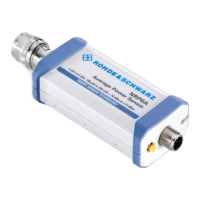Annex: Remote Control - Commands R&S NRP
1144.1400.12 Annex - I.18 E-2
Automatic filter setting: SENS:AVER:COUN:AUTO:TYPE NSR | RES is used to select whether the
noise component should remain below a specific threshold (NSR) or the measurement result should be
stable up to a specific accuracy (RES). To avoid long measurement times,
SENS:AVER:COUNT:AUTO:MTIM can be used to specify a maximum measurement time. The
maximum filter length is set such that the measurements do not exceed this time, even if the desired
stability has not yet been obtained.
Example:
*RST
SENS:AVER:STAT ON (activates filtering)
SENS:AVER:COUN:AUTO ON (switches on filter-length automatic mode)
SENS:AVER:COUN:AUTO:TYPE RES (sets automatic mode to RESolution)
SENS:AVER:COUN:AUTO:RES 3 (maintains 3 places noise-free in the result)
INIT
FETCh?
Example:
*RST
SENS:AVER:STAT ON (activates filtering)
SENS:AVER:COUN:AUTO ON (switches on filter-length automatic mode)
SENS:AVER:COUN:AUTO:TYPE NSR (sets automatic mode to NSRatio)
SENS:AVER:COUN:AUTO:NSR 0.01 DB (maximum noise component in the result)
SENS:AVER:COUN:AUTO:MTIM 10 S (but does not measure more than 10 s)
INIT
FETCh?
All intermediate pushed values delivered by the first filter stage are stored in the filter. The earliest
measured value is ousted out of the filter, since the filter has only a limited length. SENS:AVER:TCON
MOV | REP is used to set when the filter algorithm is to be applied to the filter. With the setting
MOVing, a new measure value is calculated for each new intermediate measured value. This is the
default setting in the LOCAL mode. SENS:AVER:TCON REPeat is set in the REMOTE mode. In this
particular case, new measured values are calculated when all intermediate measured values have
been replaced by new ones.
Note: Changing from SENS:AVER:TCON MOV to REP in the LOCAL-REMOTE
transition causes the update rate of measured values to be reduced, since
the filter must be completely filled for each new measured value.

